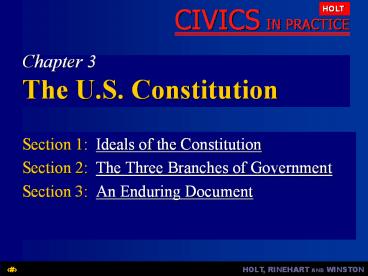Chapter 3 The U.S. Constitution - PowerPoint PPT Presentation
1 / 18
Title:
Chapter 3 The U.S. Constitution
Description:
Chapter 3 The U.S. Constitution Section 1: Ideals of the Constitution Section 2: The Three Branches of Government Section 3: An Enduring Document – PowerPoint PPT presentation
Number of Views:105
Avg rating:3.0/5.0
Title: Chapter 3 The U.S. Constitution
1
Chapter 3The U.S. Constitution
- Section 1 Ideals of the Constitution
- Section 2 The Three Branches of Government
- Section 3 An Enduring Document
2
Section 1 Ideals of the Constitution
- The Main Idea
- The Constitution is an agreement between the
citizens of the Untied States and the government
that the people will grant powers to the
government. In return, the government is to
carry out the goals of the Constitution. - Reading Focus
- How did the Pilgrims influence the framers of the
Constitution? - What are the goals of the U.S. government as
outlined in the Constitution? - What are the powers the Constitution gives to the
federal and state governments?
3
The pilgrims influenced the framers of the
Constitution
Section 1 Ideals of the Constitution
- November 21, 1620The Mayflower Compact was
written to create a new government of popular
sovereignty for the colonists.
4
Goals of the U.S. Constitution
Section 1 Ideals of the Constitution
- To form a more perfect union
- Establish justice
- Insure domestic tranquility
- Provide for the common defense
- Promote the general welfare
- Secure the blessings of liberty
5
The Constitution establishes federal and state
powers.
Section 1 Ideals of the Constitution
- Delegated powers give the federal government
strength to protect and serve the country. - Reserved powers are kept for the states to manage
their own affairs and to balance the power of the
federal government. - Concurrent powers are held by both state and
federal governments.
6
The Constitution establishes federal and state
powers. (continued)
Section 1 Ideals of the Constitution
- The federal government is the supreme law of the
land that all states must defer to. - Limited government checks the powers of the
federal and state governments. - The Bill of Rights protects the powers of the
people.
7
SECTION 1
Question Why did the Constitution establish
separate powers for the state and federal
governments?
8
Section 2 The Three Branches of Government
- The Main Idea
- The Constitution prevents any person, or any part
of the government, from taking too much power.
It does this by creating three separate branches
of the federal government and distributing power
among them. - Reading Focus
- Why does the Constitution provide for the
separation of powers? - What are the main responsibilities of each of the
three branches of government? - How does the system of checks and balances work?
9
The Constitution provides for the separation of
powers.
Section 2 The Three Branches of Government
- Ensures no person or branch of government is too
powerful - Distributes power among three branches of
government - Legislative
- Judicial
- Executive
10
Responsibilities of the three branches of
government
Section 2 The Three Branches of Government
- Legislativethe lawmaking branch
- Executiveexecutes the countrys laws
- Judicialinterprets laws and punishes law breakers
11
The system of checks and balances
Section 2 The Three Branches of Government
- Each branch has powers no other branch can
assume. - Each branch has powers that limit the powers of
the other branches.
12
SECTION 2
Question Why does the Constitution provide for
the separation of powers?
13
Section 3 An Enduring Document
- The Main Idea
- The Constitution is an enduring document that has
met the needs of a changing country for more than
200 years. - Reading Focus
- How did the framers envision change when writing
the Constitution? - What are two ways in which the Constitution may
be changed?
14
The Constitution is a living document.
Section 3 An Enduring Document
- It was designed to adapt to a growing, changing
nation. - There are three ways the Constitution can be
adapted to changing needs - Amendmenta written change to the Constitution
- Interpretationwhen the Constitution is
interpreted in a new way - Customtraditions often referred of as the
unwritten Constitution
15
The flexible Constitution benefits the United
States.
Section 3 An Enduring Document
- The government adapts to the changing conditions
and needs of the country. - The people can repeal constitutional amendments
if necessary. - Minimum wage laws are an example of flexible
interpretation of the Constitution.
16
Amendments to the Constitution
Section 3 An Enduring Document
- Proposal by two-thirds vote in both houses of
Congress, or by two thirds of state legislatures
calling for a national convention to propose the
amendment - The proposal must be ratified by three fourths of
the states. - Proposals may be sent to the state legislatures
or to state conventions for ratification. - Approved amendments may be repealed by new
amendments.
17
SECTION 3
Question Why is the Constitution called a
living document?
because its provisions enable government to
change to meet changing conditions
18
Chapter 3 Wrap-Up
- What are the six goals of government as stated in
the Preamble of the U.S. Constitution? - What are the three branches of the federal
government, and what are their primary
responsibilities? - How does the system of checks and balances in the
federal government work? - What makes the Constitution of the United States
a living document? - How can the Constitution be amended?

